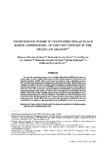Por favor, use este identificador para citar o enlazar este ítem:
http://www.alice.cnptia.embrapa.br/alice/handle/doc/577957Registro completo de metadatos
| Campo DC | Valor | Lengua/Idioma |
|---|---|---|
| dc.contributor.author | SOUZA, K. W. de | pt_BR |
| dc.contributor.author | LIMA, H. N. | pt_BR |
| dc.contributor.author | SCHAEFER, C. E. G. R. | pt_BR |
| dc.contributor.author | TEIXEIRA, W. G. | pt_BR |
| dc.contributor.author | PULROLNIK, K. | pt_BR |
| dc.contributor.author | CORRÊA, G. R. | pt_BR |
| dc.date.accessioned | 2013-08-05T23:31:43Z | - |
| dc.date.available | 2013-08-05T23:31:43Z | - |
| dc.date.created | 2009-12-15 | pt_BR |
| dc.date.issued | 2009 | pt_BR |
| dc.identifier.citation | Revista Brasileira de Ciência do Solo, v. 33, p. 1347 - 1355, 2009. | pt_BR |
| dc.identifier.uri | http://www.alice.cnptia.embrapa.br/alice/handle/doc/577957 | pt_BR |
| dc.description | Despite the agricultural importance of India Black Earth (IBE) in the Amazon region, there are few studies that report on the relation between soil texture and chemical fertility of IBE. These soils of pre-Colobian origin, with high contents of P, Ca and other nutrients are found across the Amazon valley. IBE profiles were studied to evaluate the total contents of P, its primary chemical forms and the P transformation phases in areas with IBE soils of variable texture and in adjacent reference soils. The soil texture strongly influenced soil fertility, changing in terms of transformation of the primary P forms and, consequently, predominant P forms in IBE. Soils with texture varying between clay and heavy clay had higher total P contents and primary Ca-P forms. Highest P-Al and lowest total P amounts werw observed at the site Rio Preto da Eva, where texture varies from sandy, loam to sandy clay loam. In the IBE with clay texture the amounts of soluble P, extracted with NH4CI were highest, although different from Mehlich 1-extractable amounts. | pt_BR |
| dc.language.iso | eng | eng |
| dc.rights | openAccess | eng |
| dc.subject | Amazônia Brasileira | pt_BR |
| dc.subject | Amazon black earth | pt_BR |
| dc.subject | Soil P fractionation | pt_BR |
| dc.subject | Amazon soils | pt_BR |
| dc.subject | Anthropogenic soils | pt_BR |
| dc.title | Phosphorus forms in cultivated indian black earth (anthrosols) of varying texture in the Brazilian Amazon. | pt_BR |
| dc.type | Artigo de periódico | pt_BR |
| dc.date.updated | 2013-08-05T23:31:43Z | pt_BR |
| dc.subject.thesagro | Solo | pt_BR |
| dc.subject.thesagro | Fósforo | pt_BR |
| dc.subject.thesagro | Química | pt_BR |
| dc.subject.thesagro | Textura | pt_BR |
| dc.subject.nalthesaurus | Anthrosols | pt_BR |
| dc.subject.nalthesaurus | upland soils | pt_BR |
| dc.subject.nalthesaurus | soil | pt_BR |
| dc.subject.nalthesaurus | soil chemistry | pt_BR |
| dc.subject.nalthesaurus | terra preta | pt_BR |
| riaa.ainfo.id | 577957 | pt_BR |
| riaa.ainfo.lastupdate | 2013-08-05 | pt_BR |
| dc.contributor.institution | KLEBERSON WORSLLEY DE SOUZA, UFV; HEDINALDO NARCISO LIMA, UFAM; CARLOS ERNESTO G. R. SCHAEFER, UFV; WENCESLAU GERALDES TEIXEIRA, CPAA; KARINA PULROLNIK, CPAC; GUILHERME RESENDE CORREA, UFV. | pt_BR |
| Aparece en las colecciones: | Artigo em periódico indexado (CPAC)  | |
Ficheros en este ítem:
| Fichero | Descripción | Tamaño | Formato | |
|---|---|---|---|---|
| souzakwde012009.pdf | 1.33 MB | Adobe PDF |  Visualizar/Abrir |









